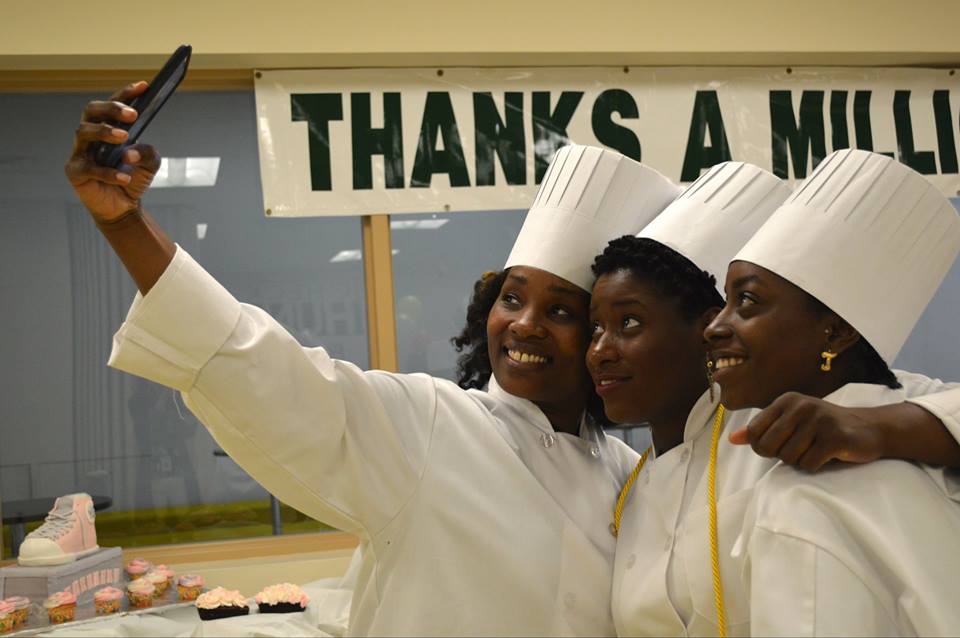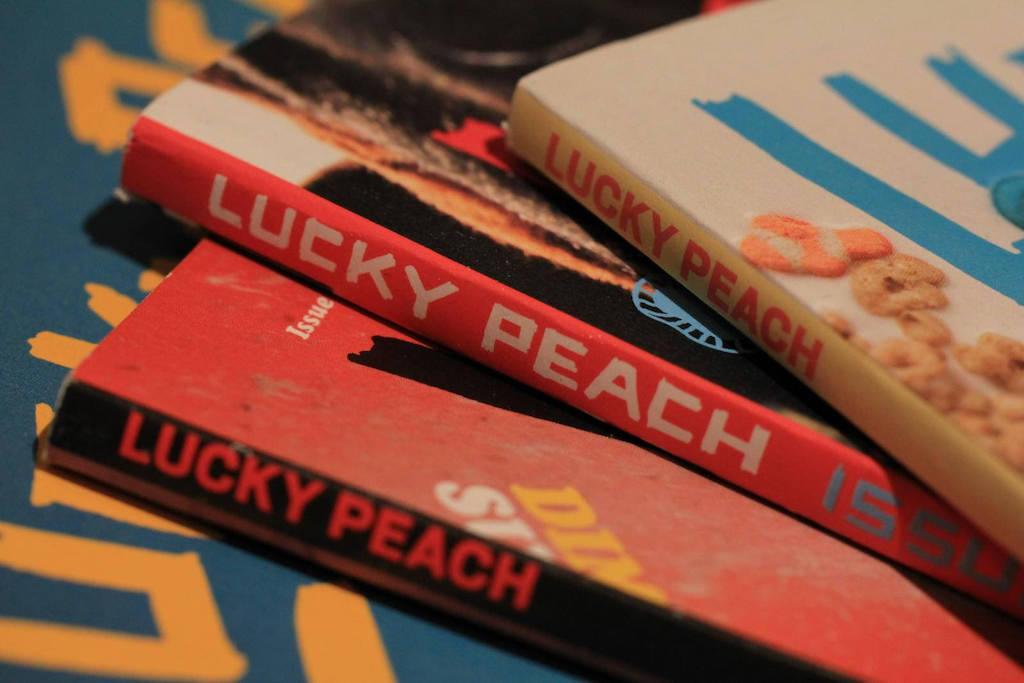
Community Foodbank of NJ
It’s a Wednesday in June. And it’s graduation day for 17 new chefs in New Jersey. Their white coats are pressed, and their paper chef hats are pinned in place.
But they’re not walking down the aisle at a storied culinary school or renown kitchen. Instead, these chefs are picking up their culinary diplomas alongside the pallets and stacks of canned goods at the Community FoodBank of New Jersey.
The 285,000-square-foot facility is massive–about five football fields in size–and it’s here that the grads have spent 16 weeks learning how to sauce, chop, dice, and even feather a duck.
“I don’t need box recipes anymore,” 35-year-old grad Terrence Shivers tells me proudly, just before the ceremony begins.
 Community FoodBank of NJ
Community FoodBank of NJ The graduates baked cakes for the special day and ate them at a reception following the ceremony
It seems an odd pairing–this Top-Chef-meets-soup-kitchen model–but the idea for a crash course in culinary ed is one that’s been hatched in dozens of food banks like this one around the country. Thirty-three of them are partners in Feeding America, an umbrella organization embracing 200 partner food banks. And there are probably others outside the network as well. The premise is simple: student chefs help the food banks pump out more meals, and in return, the students get training for steady jobs in industrial kitchens.
Says Kim Prendergast, a community health and nutrition consultant for Feeding America, “It really makes sense for food banks, who are providing meals and groceries to people who are food insecure.”
“We’ve got a lot of bad food that’s bringing down the community.”
At its best, this bootcamp model can propel students into stable positions with benefits, the kinds of jobs that might mean they’ll no longer have to make occasional trips to food banks. The hope is grads will land a job cooking in the kitchen at a local hospital, daycare, or retirement home. But when the bootcamp days are done and the wilted graduation hats have become nothing more than crinkled paper, not all of these graduates find themselves working such stable gigs.
Two months after the ceremony I attended in June, the 17 graduates of the 4-month Community FoodBank course have all found work–though only some of them are in a kitchen.
Take Victoria Ramirez. She walked down the aisle with gold honor chords around her neck. She was one of the top four students in her class. A former public relations pro who lost her job, Ramirez says she’s heading back to school this fall, and starting her own catering business, too. Meanwhile, her colleague Richard Thomas is attempting to build his own brand selling homemade soaps, not food. And grad Tyesha Boyd is staying put at her old job for now. She’s a toll booth worker–it pays well, so why rush to leave?
 Community FoodBank of NJ
Community FoodBank of NJ The graduating class of 2016
For 16 years, more than 900 people have made the pilgrimage from their disparate corners of New Jersey to this industrial corner of Hillside, where they’ve been manning the Community FoodBank’s industrial kitchen, which was built just for this culinary crash course. The trainees don’t pay tuition. If they’re accepted into the program, it’s the FoodBank that foots the bill, which costs about $5,800 per cook. It’s not a monumental expense for this tax-exempt nonprofit. The New Jersey FoodBank, which started out of the trunk of a car back in the 1970s, now rakes in about $100 million in contributions every year.
Some of the FoodBank’s students, like Ramirez, are in class to get back on their feet after a bout of unemployment. Others, like 28-year-old Rasheed Lee, are ready to land a stable job that will help keep them off the streets. “We’ve got a lot of bad food that’s bringing down the community,” Lee, who now works in a food warehouse, says of his native Newark. Today, Lee makes deliveries and pickups for a food warehouse in Jersey City.
For others, the class can serve as a pivot, a chance to make a career change. 36-year-old Mearal Washington says he’s clocked years as a corporate manager, most recently at Planet Fitness. But with the FoodBank training, he’s been able to parlay that work experience–plus a little kitchen savvy–into an assistant manager position at the new Tru Street restaurant in the Bridgewater, New Jersey mall.
 Community FoodBank of NJ
Community FoodBank of NJ Graduate Rasheed Lee shows off bread the graduates baked for the ceremony
The FoodBank’s culinary classes, which run three times a year, are built around a curriculum of three key ‘ingredients’ meant to target the root causes of job insecurity. First ingredient: the trade–all the saucing, dicing, and chopping skills. For this, the FoodBank employs two in-house chefs and one pastry pro who teach students cooking, meal planning and nutrition. The students learn how to wield a knife like an expert, and the chefs even set up ‘grab bag’ challenges for the students, in hopes of making the course as exciting as cooking looks on reality TV. When they’re not competing, students get a lot of hands-on practice prepping and serving food, as they churn out 125 meals for the FoodBanks’ staff three times a week.
The second ingredient is more like driver’s ed for kitchen work: a certification in food safety. In this part of the program, students learn about pathogens, contamination and food allergies, before taking a test from the National Restaurant Association that certifies them as “ServSafe” for five years.
“We don’t want to graduate working poor. That’s kind of antithetical to our system.”
The third and final ingredient in the course is one that’s a little harder to order up on command. The FoodBank calls this leg of the training “life skills.” These are the basics, like learning how to show up on time (er, early, actually), helping the graduates find stable jobs, offering counseling, and negotiating practical logistics like transportation and childcare.
The idea is that if this three-part recipe works, it can help reduce reliance on foodbanks, while also building a community of healthier, savvier cooks. And the chefs who graduated from the program in June have definitely upped their cooking game, even if they’re not using the skills at their bread-and-butter day jobs. One grad makes food at her local Boys and Girls Club, another cooks for the kids in her daycare, and a third is catering healthy lunches for local hair salons.
Then there’s Shivers (the grad who doesn’t need his box recipes anymore). He tells me that after years of the corporate grind, he wanted to move into a line of work he cares about. He works in the kitchen at a retirement home now, and just resigned from his job at Home Depot. The pay at the retirement home is better, but he’s up and in the kitchen at 5:30 every morning. He says there’s no doubt about it, the new job is really tough–all morning it’s non-stop, physically grueling work.
“I’m gonna give it more time tho’, because I don’t back down from challenges,” Shivers writes.
A short trip across the Hudson in New York City, executive chef Paras Shah knows the hustle of pursuing a second calling in food firsthand. He’s not a grad of the New Jersey program, but when he made a career change and started working on the line at Momofuku while attending culinary school, he made about $7.50 an hour, a far cry from the money he made in his former life–about $55,000 a year. Today, he runs the kitchen at Kat and Theo in the trendy Flatiron district. He says kitchen work isn’t just underpaid at entry-level, it’s also dangerous: long, late hours, hot oil, sharp knives, slippery floors, and dripping sweat. Plus, there’s the expense of training. Shah’s alma mater, The Institute of Culinary Education, runs around $40,000 for an 8-month course. While the primary idea at the FoodBank is to get the grads working with food, the hope is less that they’ll become executive chefs, and more that they’ll just land stable gigs.
Chef Paul Kapner who runs the New Jersey Foodbank’s academy says he’s focused on getting grads the kinds of jobs that come with perks like benefits and paid leave. Foodbank CEO Debra Vizzi echoes Kapner: “We don’t want to graduate working poor,” she says. “That’s kind of antithetical to our system.”
 Community FoodBank of NJ
Community FoodBank of NJ Another graduation day cake creation
Shah thinks if the FoodBank wants to up its game getting more students’ hands dirty in big kitchens, there’s one ingredient that’s still missing in the New Jersey course’s recipe: they need a sustained connection to local businesses and kitchens while the students are in the program, a kind of off-site foot in the door; real on-the-job training. He says if you’re really eager to learn how to be a chef, there’s only so much you can “stack in there” in an intensive 16-week course. After that, you’ve got to sweat it out in the heat of a real kitchen.









